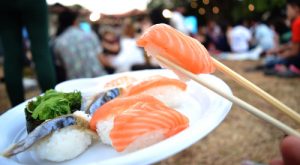Ever look in the mirror the morning after an indulgent sushi dinner only to realize that you look like a blow fish? It turns out there’s a name for this affliction: Sushi face! At least that is what actress Julianne Moore called it during an interview with New York Magazine.
To get the scoop on sushi face, we reached out to Nigma Talib, ND, a naturopathic practitioner in London, to find out the real deal with sushi face; specifically and how we can enjoy our favorite rolls and sashimi without waking up to the bloating and under-eye bags. Dr. Talib is the author of Younger Skin Starts in the Gut: 4-Week Program to Identify and Eliminate Your Skin-Aging Triggers – Gluten, Wine, Dairy, and Sugar, and has coined such terms as “wine face” and “sugar face.” So who better to ask about sushi face?
Most people might immediately pin the blame on the soy sauce (which is packed with sodium), but you might be surprised to learn that fish and rice also contain some salt. The reality is there are a number of elements in the sushi feast work together to make you retain fluid, says Dr. Talib. “Post-sushi, we all get an inflamed face because the sodium is causing water retention and even the rice plays a role,” she says. “Rice gets broken down into sugar by the digestive enzyme amylase which is found in our saliva.” This feeds bad bacteria in the gut and increases bloating.
So the bad news is that sushi face is really is a thing. But the good news is that it only lasts less than 24 hours.
Now before you go throwing in the towel on your favorite food altogether, here are some tips from Dr. Talib to help you avoid the extreme post-sushi bloat:
1. Choosing another cuisine the night before / day of a big event. (Save the sushi for a meal before a lazy weekend.)
2. Consuming more potassium to balance out all the sodium. Avocado — a popular ingredient in many rolls — is potassium-rich. Other good sources of potassium include nuts, bananas, oranges, broccoli, greens, potatoes and tomatoes.
3. Asking for low-sodium soy sauce. Many restaurants do carry low-sodium varieties, and if enough people ask for them, others will start too as well. If you are feeling adventurous, skip the soy sauce altogether and savor the natural taste of the sushi. See if this makes a noticeable improvement in your appearance the following day.


